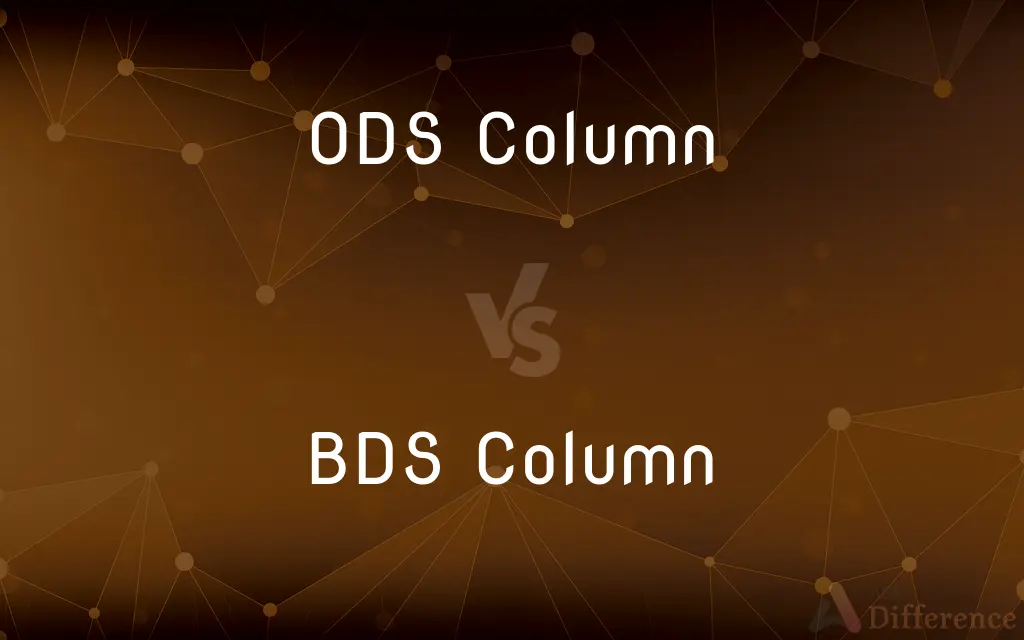ODS Column vs. BDS Column — What's the Difference?
By Tayyaba Rehman & Fiza Rafique — Published on February 16, 2024
ODS (Octadecylsilane) Columns are used in HPLC for reverse-phase chromatography with C18 hydrophobic stationary phase. BDS (Base Deactivated Silica) Columns are silica columns treated to reduce silanol activity, improving peak shapes for basic compounds.

Difference Between ODS Column and BDS Column
Table of Contents
ADVERTISEMENT
Key Differences
ODS Columns, equipped with Octadecylsilane chemically bonded to silica gel, are a mainstay in High-Performance Liquid Chromatography (HPLC) for separating non-polar to moderately polar compounds. This column type utilizes a reverse-phase mechanism, where the stationary phase is non-polar, and the mobile phase is polar, allowing for the effective separation of a wide range of molecules based on their hydrophobic interactions with the C18 bonded phase.
BDS Columns are specifically designed to mitigate the effects of silanol groups on the silica surface, which can interact unfavorably with basic compounds, leading to tailing peaks. By deactivating these silanol groups, BDS columns enhance the peak symmetry for basic analytes, making them particularly useful in applications where the analysis of basic compounds is challenging due to their interaction with active sites on untreated silica surfaces.
The choice between an ODS Column and a BDS Column typically depends on the nature of the analytes being separated. ODS columns are generally more versatile, suitable for a broad range of applications. In contrast, BDS columns are selected for their specialized ability to improve the analysis of basic compounds by providing sharper peaks and better resolution, which is crucial for quantitative analysis.
While ODS Columns are celebrated for their robustness and wide applicability in reverse-phase chromatography, BDS Columns offer a solution to specific issues encountered in the separation of basic analytes. This specialization makes BDS columns invaluable in pharmaceutical analyses and other fields where the precise quantification of basic compounds is required.
Both column types are integral tools in the analytical chemist's arsenal, chosen based on the specific requirements of the analysis. Understanding the chemical nature of the sample and the desired outcome of the chromatographic separation is key to selecting between an ODS and a BDS Column for optimal results.
ADVERTISEMENT
Comparison Chart
Stationary Phase
C18 hydrophobic phase
Silica gel treated to deactivate silanol groups
Ideal for Compounds
Non-polar to moderately polar compounds
Basic compounds with improved peak shapes
Mechanism
Reverse-phase chromatography
Specifically treated for basic analytes
Application Versatility
Broad, general-purpose
Specialized, particularly for basic compounds
Peak Shape for Basic Compounds
Generally good but can show tailing
Improved peak shapes due to reduced silanol activity
Compare with Definitions
ODS Column
The C18 coating on ODS Columns provides strong hydrophobic interactions.
The ODS column's C18 phase effectively separated the pharmaceuticals based on their hydrophobicity.
BDS Column
BDS Columns are designed to enhance peak shapes for basic analytes.
Our analysis of amines showed significantly sharper peaks using a BDS column.
ODS Column
An ODS Column is a reverse-phase HPLC column with a C18 hydrophobic stationary phase.
We used an ODS column for the separation of lipophilic compounds in our sample.
BDS Column
A BDS Column features base-deactivated silica for improved analysis of basic compounds.
The BDS column was essential for reducing the tailing of basic peaks in our chromatogram.
ODS Column
ODS Columns are known for their robustness in reverse-phase chromatography.
For our routine analysis, the ODS column's durability makes it an ideal choice.
BDS Column
The treatment of silica in BDS Columns reduces silanol activity.
By using a BDS column, we avoided the usual issues related to silanol interactions.
ODS Column
ODS Columns facilitate the separation of molecules by their polarity.
Using an ODS column, we achieved excellent separation of polar analytes in our complex mixture.
BDS Column
BDS Columns offer specialized performance in HPLC applications.
The specialized BDS column was key to achieving accurate results for our basic analytes.
ODS Column
ODS Columns are suitable for a wide range of analytical applications.
Our lab frequently utilizes ODS columns due to their versatility in analyzing diverse compounds.
BDS Column
BDS Columns are preferred for chromatography of substances prone to silanol interactions.
For our basic pharmaceutical compounds, the BDS column provided clear, symmetrical peaks.
Common Curiosities
What does ODS stand for?
ODS stands for Octadecylsilane, referring to the C18 hydrophobic phase used in the column.
Can BDS Columns separate non-basic compounds effectively?
While BDS Columns are optimized for basic compounds, they can still separate non-basic compounds but are primarily chosen for their performance with basics.
Are ODS Columns suitable for all types of HPLC solvents?
ODS Columns are compatible with a wide range of solvents, making them versatile for various HPLC applications.
Why would I choose a BDS Column over an ODS Column?
Choose a BDS Column for better peak shapes and resolution of basic compounds.
What is the primary use of an ODS Column?
It's widely used for the separation of non-polar to moderately polar compounds in HPLC.
Is there a significant price difference between ODS and BDS Columns?
The price can vary based on the manufacturer and the specific treatment of the column, with BDS Columns sometimes being more expensive due to additional processing.
How do I decide between an ODS and a BDS Column for my analysis?
Consider the nature of your analytes, especially their polarity and whether they are basic, to choose the appropriate column.
Can I use an ODS Column for sensitive analysis of basic compounds?
Yes, but a BDS Column might provide better results for basic compounds due to reduced peak tailing.
How does the BDS Column improve peak shape?
By deactivating silanol groups on the silica surface, it reduces unwanted interactions that cause tailing in basic compounds.
How long do these columns typically last?
With proper care, both ODS and BDS Columns can last for hundreds of analyses, but lifespan can vary based on usage and sample type.
What factors can affect the performance of ODS and BDS Columns?
Factors include the nature of the mobile phase, the temperature of the analysis, and the specific characteristics of the analytes being separated.
Are ODS and BDS Columns compatible with UV detection?
Yes, both column types are compatible with UV detection in HPLC.
Can both columns be used in water-based mobile phases?
Yes, both ODS and BDS Columns can be used with aqueous mobile phases, but compatibility should always be checked based on the analysis requirements.
What maintenance is required for these columns?
Regular flushing with solvents to prevent buildup and degradation of the stationary phase is recommended for both column types.
Can I use BDS Columns for LC-MS applications?
Yes, BDS Columns can be used in LC-MS, particularly when analyzing basic compounds, but always verify compatibility with your LC-MS system.
Share Your Discovery

Previous Comparison
Edward Cullen vs. Jacob Black
Next Comparison
Which vs. In WhichAuthor Spotlight
Written by
Tayyaba RehmanTayyaba Rehman is a distinguished writer, currently serving as a primary contributor to askdifference.com. As a researcher in semantics and etymology, Tayyaba's passion for the complexity of languages and their distinctions has found a perfect home on the platform. Tayyaba delves into the intricacies of language, distinguishing between commonly confused words and phrases, thereby providing clarity for readers worldwide.
Co-written by
Fiza RafiqueFiza Rafique is a skilled content writer at AskDifference.com, where she meticulously refines and enhances written pieces. Drawing from her vast editorial expertise, Fiza ensures clarity, accuracy, and precision in every article. Passionate about language, she continually seeks to elevate the quality of content for readers worldwide.
















































